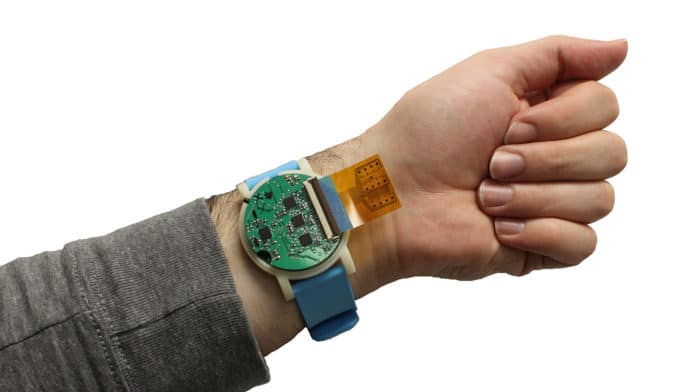Recent advances in wearable sweat (which is rich in physiological information) sensing technology have overcome many of the historic drawbacks of sweat sensing. Such sensors are now increasingly being used for monitoring multiple health-related biomarkers in real-time.
Engineering researchers at North Carolina State University have developed one more such a health tracking device with a range of impressive functionalities. The novel device, of the size of a wristwatch, can monitor an individual’s body chemistry in real-time to help improve athletic performance and identify potential health problems.
The device features a replaceable strip, embedded with chemical sensors, on its backside that rests against a user’s skin, where it comes into contact with the user’s sweat. The chemical sensors gather sweat data, which is then interpreted by hardware inside the device. The device then processes the data and sends the results to the user’s smartphone or smartwatch.
“The device is the size of an average watch, but contains analytical equipment equivalent to four of the bulky electrochemistry devices currently used to measure metabolite levels in the lab,” says Michael Daniele, co-corresponding author of a paper on the work. “We’ve made something that is truly portable so that it can be used in the field.”
According to the researchers, this metabolite monitoring device can be used for everything from detecting dehydration to tracking athletic recovery, with applications ranging from military training to competitive sports. It can measure glucose, lactate, pH, and temperature in a person’s sweat. Besides, the sweat sensor strip can be customized to monitor for other substances, such as electrolytes that can be markers for health and athletic performance.
“We’re optimistic that this hardware could enable new technologies to reduce casualties during military or athletic training, by spotting health problems before they become critical,” Daniele says. “It could also improve training by allowing users to track their performance over time. For example, what combination of diet and other variables improves a user’s ability to perform?“
The team is now conducting a study to test the technology further when it is being worn by people under a variety of conditions and to confirm that it can provide continuous monitoring when in use for an extended period of time.
“While it’s difficult to estimate what the device might cost consumers, it only costs tens of dollars to make. And the cost of the strips – which can last for at least a day – should be comparable to the glucose strips used by people with diabetes,” Daniele says.
Journal Reference
- Yokus, M. A., Songkakul, T., Pozdin, V. A., Bozkurt, A., & Daniele, M. A. (2020). Wearable multiplexed biosensor system toward continuous monitoring of metabolites. Biosensors and Bioelectronics, 153, 112038. DOI: 10.1016/j.bios.2020.112038
